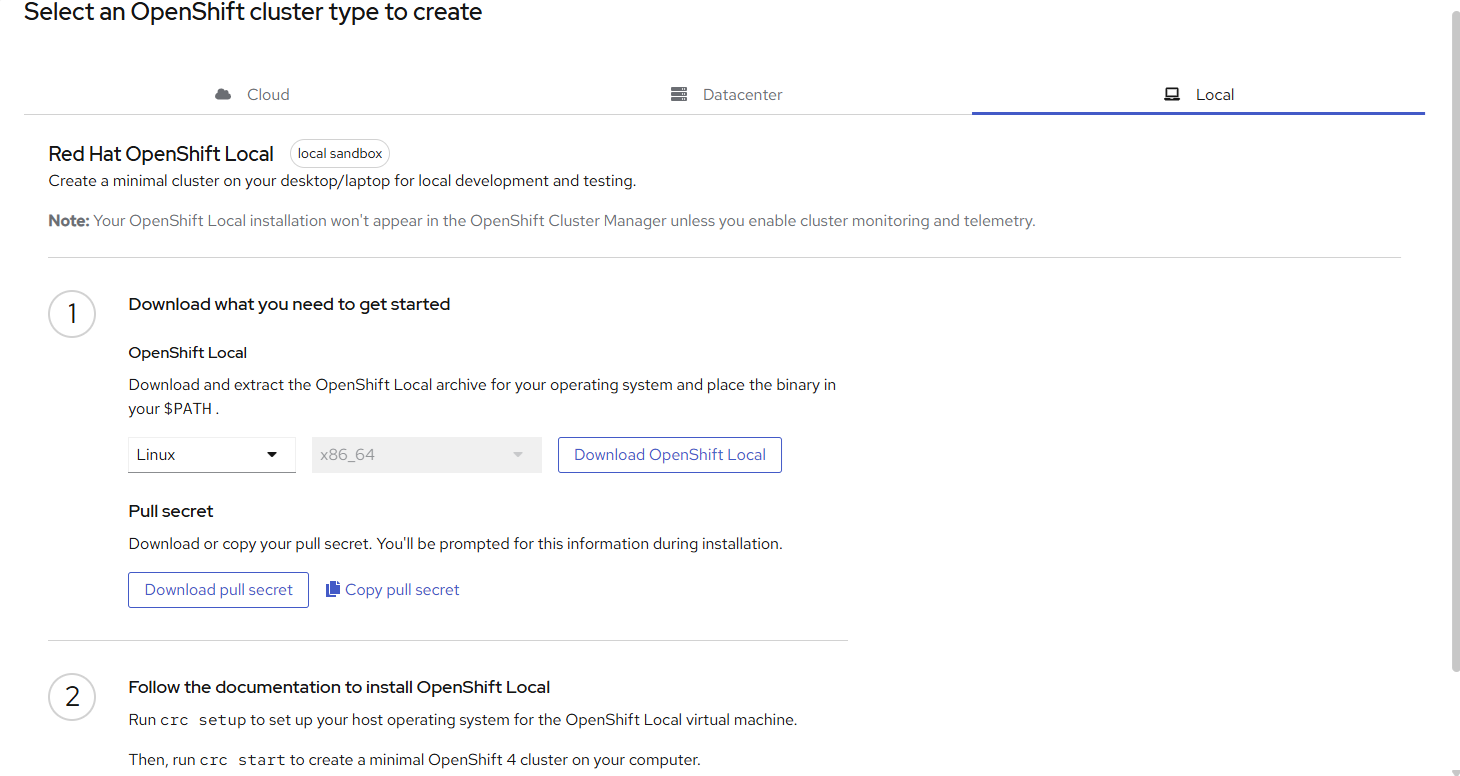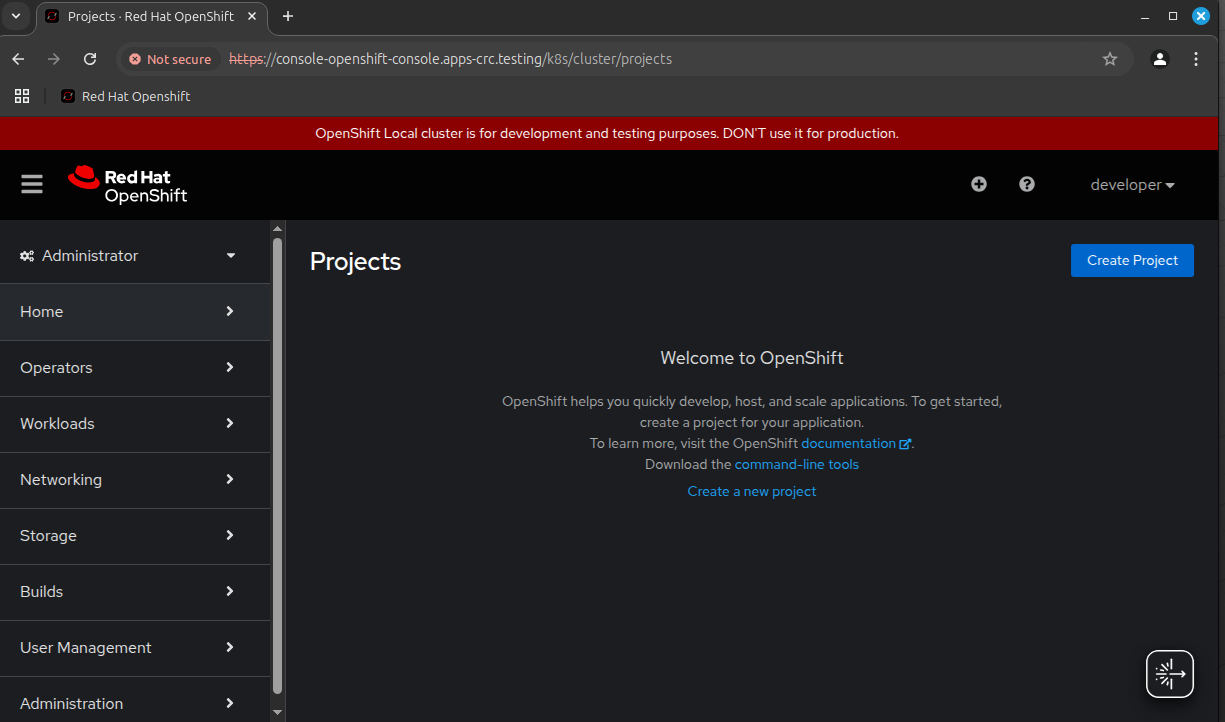Install Openshift Local
Overview
I have been wanting to learn OpenShift as a stretch goal for some time now, and decided to take the plunge today.
RedHat courses and labs are very expensive, unless you are lucky to find work sanctioned training or vouchers.
To minimize costs, I obtained the following materials:
purchased a self-paced online course by Sander Van Vugt
opted for
OpenShift Localon my PC; it’s a single node cluster intended for sandbox purposesborrowed the Manning book
"OpenShift in Action" by Jamie Duncan and John Osborne
Fun fact: OpenShift Local was previously called CRC or CodeReady Containers.
Hardware Pre-requisite
Make sure your machine has at least 32GB of RAM, the more the better.
Install Steps
Here are the steps I took to scaffold my personal environment:
Enable virtualization at the BIOS level.
Install options are MacOS, Windows, or Linux. I opted for a Linux Mint VM on VMWare Workstation Pro (free). A heads up if you choose Windows, you will need Professional edition as Home edition won’t suffice.
Make sure that you give your VM at least 16GB memory and enable VT-x.
Sign up for a free RedHat account at https://console.redhat.com
Search for OpenShift in the UI and you will see options for
Cloud,Datacenter, andLocal. SelectLocal.

From the UI, download the binary appropriate for your OS. For me, it was
crc-linux-amd64.tar.xz. Extract the tar file and place the binary in your $PATH.From the UI, download the pull secret and save it to your preferred location in the filesystem.
On the shell, start the install by running
crc setup. Output snip below.
pete@linuxvm:~$ crc setup
INFO Using bundle path /home/pete/.crc/cache/crc_libvirt_4.17.7_amd64.crcbundle
INFO Checking if running as non-root
INFO Checking if running inside WSL2
INFO Checking if crc-admin-helper executable is cached
INFO Checking if running on a supported CPU architecture
INFO Checking if crc executable symlink exists
INFO Checking minimum RAM requirements
INFO Check if Podman binary exists in: /home/pete/.crc/bin/oc
INFO Checking if Virtualization is enabled
INFO Checking if KVM is enabled
INFO Checking if libvirt is installed
INFO Checking if user is part of libvirt group
INFO Checking if active user/process is currently part of the libvirt group
INFO Checking if libvirt daemon is running
INFO Checking if a supported libvirt version is installed
INFO Checking if crc-driver-libvirt is installed
INFO Installing crc-driver-libvirt
INFO Checking crc daemon systemd service
INFO Setting up crc daemon systemd service
INFO Checking crc daemon systemd socket units
INFO Setting up crc daemon systemd socket units
INFO Checking if AppArmor is configured
INFO Updating AppArmor configuration
INFO Using root access: Updating AppArmor configuration
[sudo] password for pete:
INFO Using root access: Changing permissions for /etc/apparmor.d/libvirt/TEMPLATE.qemu to 644
INFO Checking if systemd-networkd is running
INFO Checking if NetworkManager is installed
INFO Checking if NetworkManager service is running
INFO Checking if dnsmasq configurations file exist for NetworkManager
INFO Checking if the systemd-resolved service is running
INFO Checking if /etc/NetworkManager/dispatcher.d/99-crc.sh exists
INFO Writing NetworkManager dispatcher file for crc
INFO Using root access: Writing NetworkManager configuration to /etc/NetworkManager/dispatcher.d/99-crc.sh
INFO Using root access: Changing permissions for /etc/NetworkManager/dispatcher.d/99-crc.sh to 755
INFO Using root access: Executing systemctl daemon-reload command
INFO Using root access: Executing systemctl reload NetworkManager
INFO Checking if libvirt 'crc' network is available
INFO Setting up libvirt 'crc' network
INFO Checking if libvirt 'crc' network is active
INFO Starting libvirt 'crc' network
INFO Checking if CRC bundle is extracted in '$HOME/.crc'
INFO Checking if /home/pete/.crc/cache/crc_libvirt_4.17.7_amd64.crcbundle exists
INFO Getting bundle for the CRC executable
INFO Downloading bundle: /home/pete/.crc/cache/crc_libvirt_4.17.7_amd64.crcbundle...
5.08 GiB / 5.08 GiB [---------------------------------------------------------------------------------------------------------------------------------------------------------------------------] 100.00% 10.89 MiB/s
INFO Uncompressing /home/pete/.crc/cache/crc_libvirt_4.17.7_amd64.crcbundle
crc.qcow2: 18.66 GiB / 18.66 GiB [-------------------------------------------------------------------------------------------------------------------------------------------------------------------------] 100.00%
oc: 158.81 MiB / 158.81 MiB [------------------------------------------------------------------------------------------------------------------------------------------------------------------------------] 100.00%
Your system is correctly setup for using CRC. Use 'crc start' to start the instance
- I chose to disable telemetry. You can leave it on if you want.
pete@linuxvm:~/Downloads$ crc config set consent-telemetry no
Successfully configured consent-telemetry to no
- Next, start the instance by running
crc start -p ~/Downloads/pull-secret. Note that the path to your pull secret is the location where you saved it from step #7, so replace it accordingly to fit your environment. Everything went mostly well; however it errored out due to missing packages as you can see from the output below.
pete@linuxvm:~$ crc start -p ~/Downloads/pull-secret
INFO Using bundle path /home/pete/.crc/cache/crc_libvirt_4.17.7_amd64.crcbundle
INFO Checking if running as non-root
INFO Checking if running inside WSL2
INFO Checking if crc-admin-helper executable is cached
INFO Checking if running on a supported CPU architecture
INFO Checking if crc executable symlink exists
INFO Checking minimum RAM requirements
INFO Check if Podman binary exists in: /home/pete/.crc/bin/oc
INFO Checking if Virtualization is enabled
INFO Checking if KVM is enabled
INFO Checking if libvirt is installed
INFO Checking if user is part of libvirt group
INFO Checking if active user/process is currently part of the libvirt group
INFO Checking if libvirt daemon is running
INFO Checking if a supported libvirt version is installed
INFO Checking if crc-driver-libvirt is installed
INFO Checking crc daemon systemd socket units
INFO Checking if AppArmor is configured
INFO Checking if systemd-networkd is running
INFO Checking if NetworkManager is installed
INFO Checking if NetworkManager service is running
INFO Checking if dnsmasq configurations file exist for NetworkManager
INFO Checking if the systemd-resolved service is running
INFO Checking if /etc/NetworkManager/dispatcher.d/99-crc.sh exists
INFO Checking if libvirt 'crc' network is available
INFO Checking if libvirt 'crc' network is active
INFO Loading bundle: crc_libvirt_4.17.7_amd64...
INFO Creating CRC VM for OpenShift 4.17.7...
INFO Generating new SSH key pair...
INFO Generating new password for the kubeadmin user
INFO Starting CRC VM for openshift 4.17.7...
Error starting machine: Error in driver during machine start: virError(Code=9, Domain=10, Message='operation failed: Unable to find a satisfying virtiofsd')
- Next, I installed the missing packages by running
sudo apt install virtiofsd virt-managerand tried again:
pete@linuxvm:~$ crc start -p ~/Downloads/pull-secret
INFO Using bundle path /home/pete/.crc/cache/crc_libvirt_4.17.7_amd64.crcbundle
INFO Checking if running as non-root
INFO Checking if running inside WSL2
INFO Checking if crc-admin-helper executable is cached
INFO Checking if running on a supported CPU architecture
INFO Checking if crc executable symlink exists
INFO Checking minimum RAM requirements
INFO Check if Podman binary exists in: /home/pete/.crc/bin/oc
INFO Checking if Virtualization is enabled
INFO Checking if KVM is enabled
INFO Checking if libvirt is installed
INFO Checking if user is part of libvirt group
INFO Checking if active user/process is currently part of the libvirt group
INFO Checking if libvirt daemon is running
INFO Checking if a supported libvirt version is installed
INFO Checking if crc-driver-libvirt is installed
INFO Checking crc daemon systemd socket units
INFO Checking if AppArmor is configured
INFO Checking if systemd-networkd is running
INFO Checking if NetworkManager is installed
INFO Checking if NetworkManager service is running
INFO Checking if dnsmasq configurations file exist for NetworkManager
INFO Checking if the systemd-resolved service is running
INFO Checking if /etc/NetworkManager/dispatcher.d/99-crc.sh exists
INFO Checking if libvirt 'crc' network is available
INFO Checking if libvirt 'crc' network is active
INFO Loading bundle: crc_libvirt_4.17.7_amd64...
INFO Starting CRC VM for openshift 4.17.7...
INFO CRC instance is running with IP 192.168.130.11
INFO CRC VM is running
INFO Updating authorized keys...
INFO Configuring shared directories
INFO Check internal and public DNS query...
INFO Check DNS query from host...
WARN Wildcard DNS resolution for apps-crc.testing does not appear to be working
INFO Verifying validity of the kubelet certificates...
INFO Starting kubelet service
INFO Waiting for kube-apiserver availability... [takes around 2min]
INFO Adding user's pull secret to the cluster...
INFO Updating SSH key to machine config resource...
INFO Waiting until the user's pull secret is written to the instance disk...
INFO Changing the password for the kubeadmin user
INFO Updating cluster ID...
INFO Updating root CA cert to admin-kubeconfig-client-ca configmap...
INFO Starting openshift instance... [waiting for the cluster to stabilize]
INFO 2 operators are progressing: authentication, image-registry
INFO Operator console is progressing
INFO All operators are available. Ensuring stability...
INFO Operators are stable (2/3)...
INFO Operators are stable (3/3)...
INFO Adding crc-admin and crc-developer contexts to kubeconfig...
Started the OpenShift cluster.
The server is accessible via web console at:
https://console-openshift-console.apps-crc.testing
Log in as administrator:
Username: kubeadmin
Password: (redacted)
Log in as user:
Username: developer
Password: developer
Use the 'oc' command line interface:
$ eval $(crc oc-env)
$ oc login -u developer https://api.crc.testing:6443
- If everything went well, you will be provided with login instructions to start creating new OpenShift projects.

Install Issues
For me, the cluster wouldn’t boot unless I temporarily disabled WSL and memory integrity. It may or may not be relevant for you.
Next Steps
I plan on first learning the fundamentals of Openshift, deploying some apps, and exploring integrations with HashiCorp Vault since dynamic secrets management is something I’ve been focusing on extensively for customers recently. Thanks for reading!